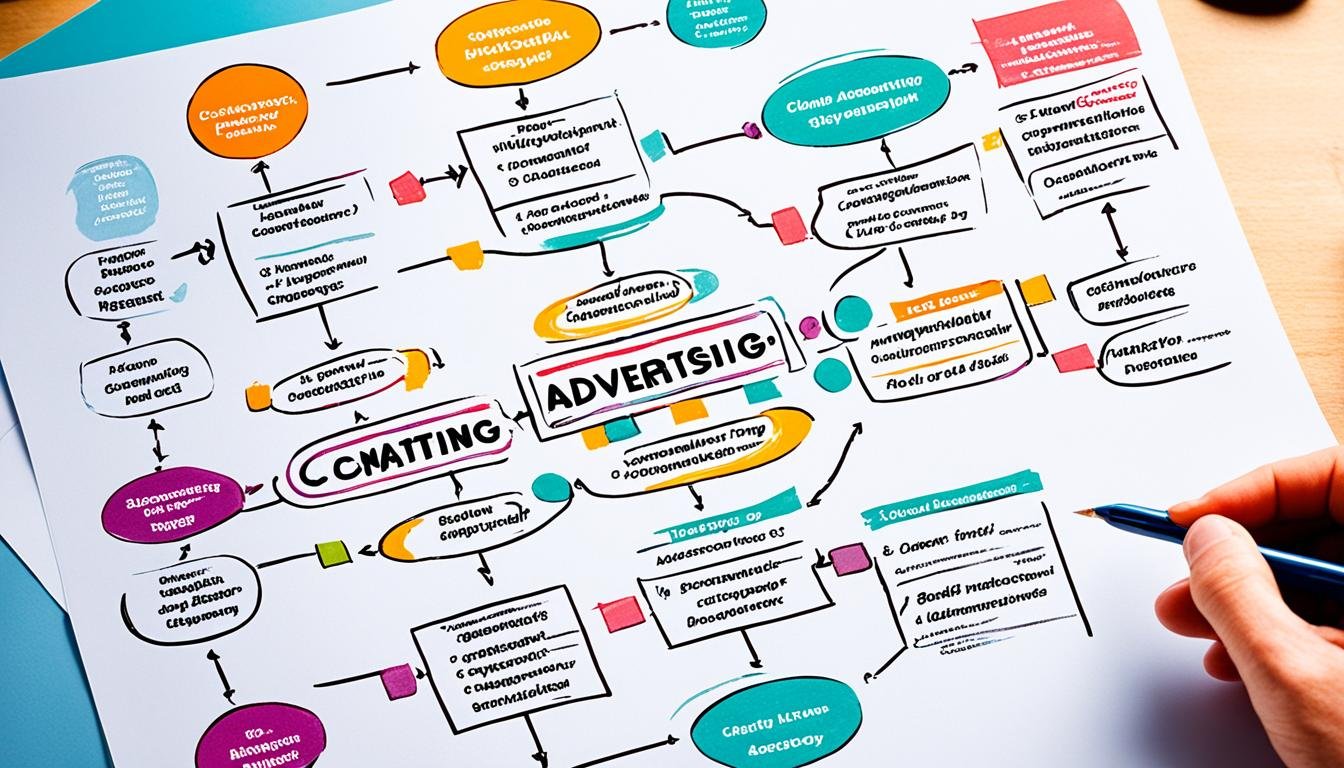Advertising Law Basics for Small Business Owners
Small business owners in the U.S. spend around $500 billion every year on ads. This shows how vital advertising is for reaching people and building your brand. But, advertising comes with legal responsibilities. It’s crucial for owners to understand laws to protect their businesses and keep customers’ trust.
We’re diving into the essential advertising law facts you need to know. This includes what you can and can’t do in ads to avoid tricking consumers. By staying informed and following the law, you’ll be on the right track to run successful ad campaigns while being ethical.
Key Takeaways:
- Federal and state laws govern how products can be advertised, and small business owners must adhere to truth-in-advertising rules set by the Federal Trade Commission.
- Deceptive ads include statements that mislead consumers or omit important information, while unfair ads cause substantial consumer injury that could not reasonably be avoided.
- Advertisers must have a reasonable basis to support their claims and ensure they can substantiate their statements before running an ad.
- The FTC evaluates ads from the perspective of a “reasonable consumer” and considers both express and implied claims.
- Small business owners can access resources and guidance from the FTC to stay compliant with advertising laws and protect their businesses.
What Makes an Advertisement Deceptive?
The FTC says an ad is deceptive if it could lead people to misunderstand. This can be by telling half-truths or not saying everything. If this deception changes someone’s mind about a product, it’s not okay.
Ads must have solid proof for what they claim, both directly and indirectly. This means they need to be able to back up what they say. They do this by showing they are honest and true in their ads.
“An advertisement is considered deceptive when it includes statements or omits information that is likely to mislead consumers who are acting reasonably under the given circumstances.”
Deceptive ads lie in many ways: making false statements, stretching the truth, or leaving out important facts. These tricks are used to lead people into buying things based on false beliefs.
The FTC has set rules to protect us from these tricky ads. These rules aim to make sure we get the real story about products when we decide to buy them. If an ad lies, the company behind it can get into trouble.
Examples of Deceptive Advertising
Deceptive ads show up in many different kinds of products. Let’s look at a few examples:
- A weight loss product that claims you’ll “Lose 10 pounds in one week” with no real proof.
- A cosmetic product that says it’s made of “All-natural ingredients,” but hides the fact chemicals are added.
- A car ad that boasts about great gas mileage, but it doesn’t say this is just in ideal driving conditions.
These cases show how trickery in ads can lead to unhappy customers or wasted money.
It’s vital for ads to be fully honest, showing everything as it really is. This builds trust with those they’re trying to reach.
Looking at the image above, it’s clear why deceptive ads are a big deal. People might feel cheated or misled. This shows why it’s so important for ads to be open and truthful.
What Makes an Advertisement Unfair?
An ad is unfair if it hurts customers in a big way that they couldn’t avoid. This harm shouldn’t be less than the good the ad might bring. When deciding, the Federal Trade Commission looks at how the ad could hurt people’s health, safety, or money.
An unfair ad can result in enforcement actions, civil penalties, and consumer redress.
The FTC watches ads closely if they risk big harm that consumers can’t dodge. This might hurt folks’ health, money, or safety. The FTC aims to stop ads that are unfair and misleading.
They look at the ad’s possible harm versus any good for customers. If the harm is more, the ad is unfair. This makes sure ads put the customer first and are responsible.
Unfair advertising practices are subject to legal consequences, including enforcement actions, civil penalties, and the requirement to provide redress to affected consumers.
The FTC works to keep consumers safe and ensure a fair marketplace. Working unfairly in ads can have legal and trust-damaging results.
Examples of Unfair Advertising Practices
Unfair advertising shows up in many ways. For example:
- Misleading claims about the effectiveness or safety of a product
- Concealing important information that could influence a consumer’s decision to purchase
- Engaging in deceptive pricing strategies
- Exploiting vulnerable populations, such as children or the elderly
It’s crucial for ads to be straightforward and honest. This protects consumers and helps build a strong, truthful market.
| Consequences of Unfair Advertising | Examples |
|---|---|
| Enforcement Actions | Cease and desist orders |
| Corrective advertising requirements | |
| Civil penalties | |
| Consumer Redress | Refunds or compensation for affected consumers |
The image above shows what happens with unfair ads. It reminds us how important fair marketing is for everyone’s good.
How Does the FTC Determine if an Ad is Deceptive?
The FTC looks at ads through the eyes of the “reasonable consumer” to check for deception. They review the context and what the ad seems to say. This means both direct and indirect claims get studied closely.
Ads shouldn’t hide important facts. If key details are left out and could make people misunderstand the product, the ad might be called deceptive. The importance of these details to a consumer’s choice is crucial. Advertisers must prove their claims are true to avoid misleading anyone.
The FTC reviews ads thoroughly. They look at all parts, from what’s said to what’s left unsaid. This way, they try to make sure ads are honest and consumers are well-informed.
What Evidence Must a Company Have to Support Ad Claims?
When companies make ads, they need clear facts and good proof to support what they say. This makes sure people get true and checkable info. The proof they need changes, based on what’s being claimed.
For claims about health or safety, firms should have solid and checked scientific proof. They must do tests, studies, or scientific work that experts have looked at. The methods they use should be trusted in the science world.
Strong scientific proof makes people trust health and safety claims more. It also keeps these claims honest.
Just customer statements being happy is not enough to prove ad claims. Companies must show real evidence to support what they say.
What Advertising Claims Does the FTC Focus On?
The Federal Trade Commission (FTC) looks at many areas in advertising. Health and safety claims are top of the list. These include claims about preventing diseases or making things safer. Such ads must be backed by solid evidence.
Next, claims that are hard for people to check themselves are also big. For example, energy savings or product effectiveness. Advertisers must show proof to back these up. They aim to stop false or misleading statements.
Then, there are the claims we can decide on ourselves. This means things like taste or our personal likes. Advertisers don’t have to prove these claims scientifically. But they still have to be truthful.
The FTC checks these areas to keep ads honest. By looking at health, hard-to-check claims, and personal judgment claims, they protect us. The goal is to make sure ads tell the truth and give right info to consumers.
| FTC Focus Areas | Description |
|---|---|
| Health and Safety Claims | Claims about health or safety need strong proof. Advertisers should show evidence like scientific studies by experts. |
| Evaluating Claims | Claims you can’t check yourself, such as if a product really saves energy, must be proven with facts. |
| Subjective Claims | Things that are up to our personal taste or preference get less attention from the FTC. Advertisers must still be honest in what they say. |
How Does the FTC Decide Which Cases to Bring?
The FTC considers many things when deciding which cases to take on. It looks at the need to protect consumers from harmful practices and ensure fair advertising. Factors it considers include the area it covers, how widespread the problem is, if a company has a history of deceit, and the harm done to consumers.
“The success of the FTC in safeguarding consumer interests lies in its strategic case selection process.” – FTC Case Selection Team
Jurisdiction
The FTC is the main authority for U.S. advertising rules. It oversees most ads for products and services. Yet, some ad rules are looked after by other agencies. The FTC works with them to ensure all industries follow the right practices.
Geographic Scope
It mainly focuses on ads that reach people nationwide. For ads that are more local, it might hand cases over to state or local agencies. These local agencies are better suited to deal with smaller community issues.
Working together with the Better Business Bureau, the FTC helps solve local issues and guides businesses. This helps protect consumers in all kinds of situations.
Pattern of Deception
The FTC looks closely at companies that deceive more than once. It aims to stop these companies from tricking consumers with false ads. Tackling this problem can better protect shoppers.
Consumer Injury
Cases that have hurt many consumers come first. The FTC is concerned about the damage lying ads do. This can be a threat to health, safety, or financial stability. The main aim is to protect people from these risks.
Efforts and Collaborations
The FTC is always improving how it picks cases. It works with many groups that care about protecting consumers. By working together, the FTC gets better at stopping misleading ads.
| Factor | Considerations |
|---|---|
| Jurisdiction | FTC’s authority over most product and service ads |
| Geographic Scope | Focusing on national advertising and collaborating with state/local agencies |
| Pattern of Deception | Identifying repeat offenders and addressing deceptive practices |
| Consumer Injury | Priority given to cases with widespread consumer harm |
The FTC’s job is to protect consumers, make the marketplace fair, and build trust. By going after deceitful ads, the FTC helps shoppers feel good about their buying decisions. This is vital for a safe and honest market.
Penalties for False or Deceptive Ads
Penalties for misleading ads differ based on the violation. The Federal Trade Commission (FTC) and courts can enforce various penalties. This is done to make sure companies follow advertising laws.
Cease and Desist Orders: When ads are false or misleading, the FTC can order a stop. Companies must prove the truth in future ads. Breaking this order can lead to fines or other punishments.
Civil Penalties: Those breaking advertising laws face civil penalties. This includes money ranging from thousands to millions. These penalties help stop misleading ads in the future.
Consumer Redress: Advertisers guilty of false ads may need to refund consumers. This aims to fix the harm caused and rebuild trust.
Corrective Advertising and Disclosures: The FTC might tell advertisers to correct their ads or add more information. This helps ensure consumers get true details for their buying choices.
“False or deceptive ads are harmful. The FTC and courts’ penalties protect people, ensure fair play, and discourage lying in ads.”
Example: Penalties for False or Deceptive Ads
| Penalty | Description |
|---|---|
| Cease and Desist Orders | Orders requiring companies to stop running deceptive ads and substantiate future claims |
| Civil Penalties | Fines imposed by the FTC or the courts, ranging from thousands to millions of dollars |
| Consumer Redress | Full or partial refunds to affected consumers to rectify the harm caused by deceptive ads |
| Corrective Advertising and Disclosures | Requirements for advertisers to engage in corrective advertising or provide additional disclosures to rectify misinformation |
The FTC uses penalties to keep advertising honest and protect buyers from lies.
Conclusion
Small business owners are essential in the market. They must follow advertising rules to protect their businesses. These rules, like those by the FTC, are key to avoiding deception. They must prove their claims are true, backed by evidence. This earns consumer trust and keeps the market fair.
The FTC gives tools and guidance on ad laws to small businesses. This helps them stay compliant and make smart advertising choices. Abiding by these rules, businesses can win over trust. This trust is vital for their success in a tough market.
Bringing fairness to ads is a team effort. When small businesses follow ad laws, they show they value honesty. This helps them gain trust from customers. In turn, this makes the business world more trustworthy. Everyone benefits from a market built on honesty.







